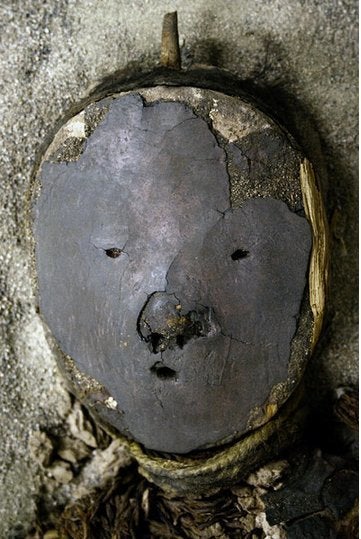
on |
Trekking through Chile's Atacama Desert 7000 years ago, hunter-gatherers known as the Chinchorro walked in the land of the dead. Thousands of shallowly buried human bodies littered the earth, their leathery corpses pockmarking the desolate surroundings. According to new research, the scene inspired the Chinchorro to begin mummifying their dead, a practice they adopted roughly 3000 years before the Egyptians embraced it.
Archaeologists have long studied how the Chinchorro made their mummies, the first in history, says ecologist Pablo Marquet of the Pontifical Catholic University of Chile in Santiago. After removing the skin to be dried, the hunter-gatherers scooped out the organs and stuffed the body with clay, dried plants, and sticks. Once they reattached the skin, embalmers painted the mummy shiny black or red and put a black wig on its head. Covering the corpses' faces were clay masks, some molded into an open-mouthed expression that later inspired Edvard Munch's famous painting The Scream.
Few scientists have tackled the mystery of why the Chinchorro started to mummify their dead in the first place. Complicated cultural practices such as mummification, Marquet says, tend to arise only in large, sedentary populations. The more people you have in one place, the more opportunity for innovation, development, and the spread of new ideas. The Chinchorro don't fit that mold. As nomadic hunter-gatherers, they formed groups of about only 100 people.
To solve the mystery, Marquet and his colleagues needed to go back in time. Using data from ice cores in the Andes, the researchers reconstructed the climate of the region where the Chinchorro lived: the northern coast of Chile and the southern coast of Peru, along the western edge of the Atacama Desert. Before 7000 years ago, the area was extremely arid, the team found, but then it went through a wetter period that lasted until about 4000 years ago. Analyses of carbon-dated Chinchorro artifacts, such as shell piles (known as middens) and mummies, suggest that the rainier conditions supported a larger population, peaking about 6000 years ago.
The team calculated, based on the demographics of hunter-gatherers, that a single Chinchorro group of roughly 100 people would produce about 400 corpses every century. These corpses, shallowly buried and exposed to the arid Atacama climate, would not have decomposed, but lingered. Given that the Chinchorro settled the Atacama coast roughly 10,000 years ago, the researchers argue that by the time the practice of mummification started about 7000 years ago, a staggering number of bodies would have piled up. A single person was likely to see several thousand naturally mummified bodies during his or her lifetime, the team reports online today in the Proceedings of the National Academy of Sciences. The number increased over the years, until mummies "became part of the landscape," Marquet says.
This constant exposure to natural mummies may have led to a cult of the dead involving artificial mummification. "The dead have a huge impact on the living," Marquet says, citing work by psychologists and sociologists that shows that exposure to dead bodies produces tangible psychological and social effects, often leading to religious practices. "There's a conflict between how you think of someone alive and dead," he says. Religious practices and ideas—such as funerals, wakes, and the belief in ghosts—help resolve that conflict. "Imagine living in the barren desert with barely anything, just sand and stone," he says. Barely anything, that is, except for hundreds, if not thousands, of dead bodies that never decay. One would feel "compelled somehow to relate" to the corpses, he says, speculating that the Chinchorro made mummies in order to come to terms with the continued presence of their dead. When the climate turned dry again and food supplies dwindled, Marquet says, the population dropped. The complex Chinchorro embalming practices also petered out around that time.
Vicki Cassman, an anthropologist and art conservator at the University of Delaware, Newark, who specializes in Andean archaeology, says she's impressed with the study's multidisciplinary approach and agrees that this could explain the Chinchorro practice of mummification. Applying an ecological population model to explain the development of mummification is a fresh approach and "as convincing an argument as we have been able to get to date." However, she says, our understanding of the ideological complexity that led to Chinchorro mummies still needs "fleshing out." "I know," she jokes. "Bad pun."
ScienceNOW, the daily online news service of the journal Science
